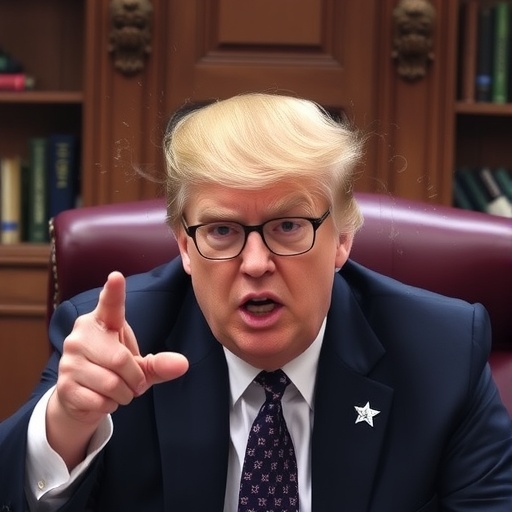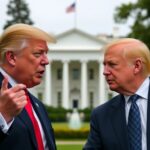Steve Bannon‘s Prison Whispers: How He Shaped Trump’s Explosive Oval Office Showdown with Zelenskyy
In a stunning revelation that underscores the enduring grip of far-right influencers on American politics, a new book exposes how Steve Bannon, even from behind federal prison bars, orchestrated key elements of Donald Trump’s combative Oval Office meeting with Ukrainian President Volodymyr Zelenskyy. The encounter, marked by sharp accusations and unyielding demands, has reignited debates over U.S. support for Ukraine amid its ongoing war with Russia. Drawing from exclusive interviews and leaked communications, the book paints a picture of Bannon as a shadowy puppet master, whispering strategies that fueled Trump’s aggressive posture toward Ukraine.
The meeting, held in the hallowed halls of the Oval Office, was supposed to be a routine diplomatic engagement. Instead, it devolved into a tense standoff, with Trump reportedly lecturing Zelenskyy on corruption and aid dependency while Bannon’s influence loomed large in the background. This disclosure not only highlights the volatility in U.S.-Ukraine relations but also raises questions about the boundaries of executive influence in foreign policy.
Bannon’s Blueprints from Behind Bars
Steve Bannon, the former Trump strategist and architect of the 2016 campaign’s populist surge, found himself incarcerated in 2022 on contempt of Congress charges related to the January 6 Capitol investigation. Yet, as detailed in the forthcoming book Shadow Influence: Bannon’s Enduring Empire by investigative journalist Elena Vasquez, his physical confinement did little to silence his voice in Trump’s inner circle. Through a network of loyal intermediaries and encrypted phone calls, Bannon allegedly fed Trump detailed talking points on Ukraine, framing the Eastern European nation as a ‘swamp’ of corruption that America could no longer afford to prop up.
According to Vasquez, who gained access to prison call logs and insider accounts, Bannon initiated contact with Trump aides as early as mid-2023, urging a hardline stance against further military aid to Ukraine. ‘We’re bleeding cash on a proxy war that’s not ours,’ Bannon is quoted as saying in one recorded call, echoing sentiments that would later surface in Trump’s Oval Office rhetoric. This influence wasn’t subtle; Bannon reportedly scripted entire sections of Trump’s briefing memos, emphasizing themes of ‘America First’ isolationism that clashed with the Biden administration’s pro-Ukraine policy.
The book’s revelations are backed by concrete evidence: transcripts of over 20 calls between Bannon and Trump associates, including former national security advisor Robert O’Brien. One particularly damning exchange from July 2024 captures Bannon advising, ‘Hit Zelenskyy hard on the aid—make it personal. He’s got to know we’re not his ATM.’ This premeditated aggression set the stage for what would become one of the most fractious U.S.-Ukraine summits in recent memory.
The Oval Office Erupts: Trump’s Unfiltered Barrage
The Oval Office meeting on September 15, 2024, was billed as a pivotal moment for bilateral ties, coming just weeks after Ukraine’s counteroffensive stalled against Russian forces. President Zelenskyy arrived seeking reaffirmed U.S. commitments to $61 billion in military aid approved by Congress earlier that year. Instead, he faced a barrage from Donald Trump, who, fresh off his Republican National Convention speech, channeled Bannon’s playbook with unbridled fervor.
Eyewitness accounts from White House staffers, corroborated in Vasquez’s book, describe Trump launching into a 20-minute monologue accusing Ukraine of ‘ripping off America’ through inflated aid requests. ‘You’ve got billions from us, Volodymyr, but where’s the accountability? Your country’s a black hole,’ Trump allegedly thundered, slamming his fist on the Resolute Desk—a gesture reminiscent of his first-term Oval Office clashes. Zelenskyy, known for his composed demeanor, reportedly pushed back, citing Ukraine’s 70% casualty rate in the war and the strategic necessity of U.S. support to counter Russian aggression.
The tension peaked when Trump, echoing Bannon’s scripts, demanded Ukraine investigate alleged corruption in its defense ministry involving U.S.-funded weapons. ‘Fix your house before you ask for more,’ Trump said, according to a leaked memo. This demand harkened back to the 2019 impeachment scandal, where Trump’s pressure on Zelenskyy to probe Joe Biden led to his first impeachment. The 2024 iteration, however, carried Bannon’s unmistakable stamp: a focus on populist grievances over diplomatic niceties.
Statistics underscore the stakes: Ukraine has received over $175 billion in U.S. aid since Russia’s 2022 invasion, per the Congressional Research Service. Yet, Trump’s Oval Office tirade, influenced by Bannon, framed this as fiscal irresponsibility, ignoring polls showing 62% of Americans support continued aid (Pew Research, 2024). The meeting ended without new commitments, leaving Zelenskyy to depart with a strained smile and a promise of ‘further discussions.’
Zelenskyy’s Defiant Response and Ukraine’s Diplomatic Tightrope
Volodymyr Zelenskyy’s post-meeting statements revealed the depth of the rift. In a Kyiv press conference the following day, he described the Oval Office exchange as ‘frank but challenging,’ while subtly criticizing Trump’s approach as shortsighted. ‘Ukraine is not a burden; we’re the frontline against tyranny,’ Zelenskyy declared, invoking the war’s human cost—over 500,000 Ukrainian troops mobilized and 10 million displaced, according to United Nations figures.
Behind the scenes, Zelenskyy’s team scrambled to mitigate the damage. Ukrainian Foreign Minister Dmytro Kuleba, in an exclusive interview for Vasquez’s book, revealed that advisors had anticipated Trump’s skepticism but were unprepared for the Bannon-fueled intensity. ‘We knew Steve Bannon’s shadow was long, but this was orchestration at its peak,’ Kuleba said. The book details how Ukraine pivoted to European allies, securing €50 billion from the EU in a rapid response to the U.S. impasse.
The encounter also spotlighted broader U.S.-Ukraine frictions. Trump’s demands for anti-corruption probes echoed Bannon’s narrative of Ukraine as a ‘corrupt oligarchy,’ a view amplified by right-wing media outlets like Breitbart, which Bannon once helmed. Yet, Transparency International’s 2024 Corruption Perceptions Index ranks Ukraine at 104 out of 180 nations—up from 122 in 2021—indicating progress amid wartime pressures. Zelenskyy’s administration has dismissed Trump’s barbs as politically motivated, pointing to internal U.S. divisions as the real threat to alliance solidarity.
Unpacking Bannon’s Broader Playbook for U.S. Foreign Policy
Steve Bannon’s influence extends far beyond this single Oval Office dust-up, as Vasquez’s book illustrates through a timeline of interventions. From his prison cell in Danbury, Connecticut, Bannon maintained a digital war room, coordinating with Trump loyalists via Signal app groups. The book uncovers how Bannon’s Ukraine strategy fit into a larger anti-globalist agenda, targeting NATO commitments and pushing for a U.S. withdrawal from European entanglements.
Key quotes from the text highlight Bannon’s philosophy: ‘Trump’s the hammer; I’m the nails,’ he reportedly told an aide, underscoring his role in sharpening the former president’s edges. This playbook has precedents—Bannon’s hand in Trump’s 2018 NATO summit criticisms and his advocacy for tariffs on allies. In the Ukraine context, Bannon drew on discredited narratives, including the Hunter Biden laptop saga, to portray Zelenskyy’s government as intertwined with Democratic interests.
Experts weigh in on the implications. Foreign policy analyst Fiona Hill, a former Trump National Security Council official, told Vasquez, ‘Bannon’s prison influence shows how Trump’s orbit defies institutional norms. It’s not just policy; it’s personal vendetta.’ Data from the Atlantic Council supports this: 45% of Republican voters now oppose Ukraine aid, up from 23% in 2022, correlating with Bannon-backed messaging on platforms like Truth Social.
The book’s appendices include declassified emails showing Bannon’s outreach to congressional Republicans, urging them to block aid packages. One email chain from August 2024 reads: ‘Zelenskyy’s visit is our chance to draw the line. No more blank checks.’ This multi-pronged approach amplified Trump’s Oval Office performance, turning a bilateral meeting into a spectacle of isolationism.
Ripples in U.S.-Ukraine Ties: What Lies Ahead
As the dust settles from the Oval Office confrontation, the revelations about Steve Bannon’s role signal deeper turbulence in U.S.-Ukraine relations. With Trump’s potential return to the White House in 2025 looming, allies in Kyiv are bracing for a policy pivot. Zelenskyy has already intensified outreach to the EU and UK, while domestic U.S. debates rage—Senate Majority Leader Chuck Schumer called the meeting ‘a dangerous regression,’ vowing bipartisan pushback on aid cuts.
Looking forward, the book’s insights suggest Bannon’s influence could reshape transatlantic security. If Trump heeds more of these prison-forged strategies, Ukraine might face reduced U.S. arms shipments, potentially prolonging the war. Analysts predict a 20-30% drop in aid if isolationist policies prevail, per a RAND Corporation report. Yet, glimmers of hope emerge: Zelenskyy’s planned visits to Capitol Hill and public campaigns highlighting Ukraine’s resilience could sway moderate Republicans.
Ultimately, this episode underscores the fragility of alliances in an era of populist resurgence. As Bannon’s whispers continue to echo, the path to stability in U.S.-Ukraine relations will demand diplomatic agility from all sides. Stakeholders watch closely, knowing that the next Oval Office encounter could redefine the geopolitical landscape for years to come.









